Why this resume works
- Quantifies accomplishments: By integrating clear metrics into their accomplishments, like a 30% efficiency boost and $200,000 cost savings, the applicant showcases tangible impact and value.
- Showcases career progression: The career trajectory from systems analyst to solutions architect reflects an impressive journey of growing responsibilities and expertise in system optimization and strategic leadership.
- Illustrates problem-solving ability: Implementing cloud solutions that saved $100,000 annually highlights the applicant’s initiative and effective problem-solving skills.
More Solutions Architect Resume Examples
Explore our solutions architect resume examples to see how to spotlight your skills in system design, cloud integration, and project management. Use these samples to craft a standout resume showcasing your expertise and technical achievements.
Entry-level solutions architect
Why this resume works
- Effective use of keywords: Strategically incorporating role-relevant keywords like “cloud solutions” and “cost reduction strategies” ensures the resume passes applicant tracking systems (ATS) effectively.
- Centers on academic background: Highlighting higher education from prestigious universities underlines the applicant’s strong academic background, important for early career success.
- Shows digital literacy: Technical roles showcasing cloud architecture and system optimization emphasize advanced computer skills, key for tech-driven workplaces.
Mid-level solutions architect
Why this resume works
- Points to measurable outcomes: Quantifiable achievements like boosting app speed by 30% and saving $100K annually showcase the applicant’s ability to drive impactful changes and deliver measurable results.
- Demonstrates language abilities: Language skills in Spanish, Mandarin, and French reinforce the applicant’s versatility in cross-cultural communication, helping their skill set stand out in global companies.
- Displays technical expertise: Certifications like AWS Certified Solutions Architect and expertise in CI/CD implementation highlight advanced technical knowledge important for solving complex cloud architecture challenges effectively.
Experienced solutions architect
Why this resume works
- Showcases impressive accomplishments: By implementing secure cloud solutions saving $1M annually, the applicant’s accomplishments reflect impactful contributions to business goals and efficiency improvements.
- Focuses on work history: The applicant uses a chronological resume format, effectively emphasizing extensive career experience through a clear progression of roles and responsibilities.
- Emphasizes leadership skills: Leading projects that improved system efficiency by 30% illustrates how the applicant applies leadership skills to drive significant organizational changes.
Solutions Architect Resume Template (Text Version)
Karen Gonzalez
Brookfield, WI 53005
(555)555-5555
Karen.Gonzalez@example.com
Professional Summary
Dynamic Solutions Architect with 8 years optimizing systems and architectures. Proven expertise in cloud computing and security reducing costs and enhancing productivity. Skilled in agile, project leadership with strong results.
Work History
Solutions Architect
Tech Innovate Labs – Brookfield, WI
May 2022 – July 2025
- Architected scalable systems improving efficiency by 30%
- Led a team of 10 developers for agile transformation
- Reduced infrastructure costs by 0,000 annually
IT Solutions Consultant
Digital Dynamics Corp – Waukesha, WI
February 2018 – April 2022
- Optimized client systems boosting productivity by 25%
- Implemented cloud solutions saving 0,000 yearly
- Coordinated cross-functional teams to enhance UX
Systems Analyst
Innovate Solutions Ltd. – Brookfield, WI
January 2016 – January 2018
- Analyzed system needs reducing downtime by 15%
- Developed software solutions enhancing system speed
- Integrated new technologies improving data security
Languages
- Spanish – Beginner (A1)
- Mandarin – Beginner (A1)
- German – Beginner (A1)
Skills
- Cloud Computing
- Enterprise Architecture
- Agile Methodologies
- DevOps Practices
- Project Management
- Data Analysis
- System Integration
- Network Security
Certifications
- AWS Certified Solutions Architect – Amazon Web Services
- Certified Information Systems Security Professional – ISC2
- Microsoft Certified: Azure Solutions Architect Expert – Microsoft
Education
Master’s Computer Science
Stanford University Stanford, California
May 2015
Bachelor’s Information Technology
California Polytechnic State University San Luis Obispo, California
May 2013
Related Resume Guides
Advice for Writing Your Solutions Architect Resume
Learn how to write a resume for a solutions architect role. Discover how to highlight your knack for designing innovative systems and driving tech success.
Whether you’re crafting software solutions or streamlining processes, these tailored tips will help you shine in the world of architecture and technology.
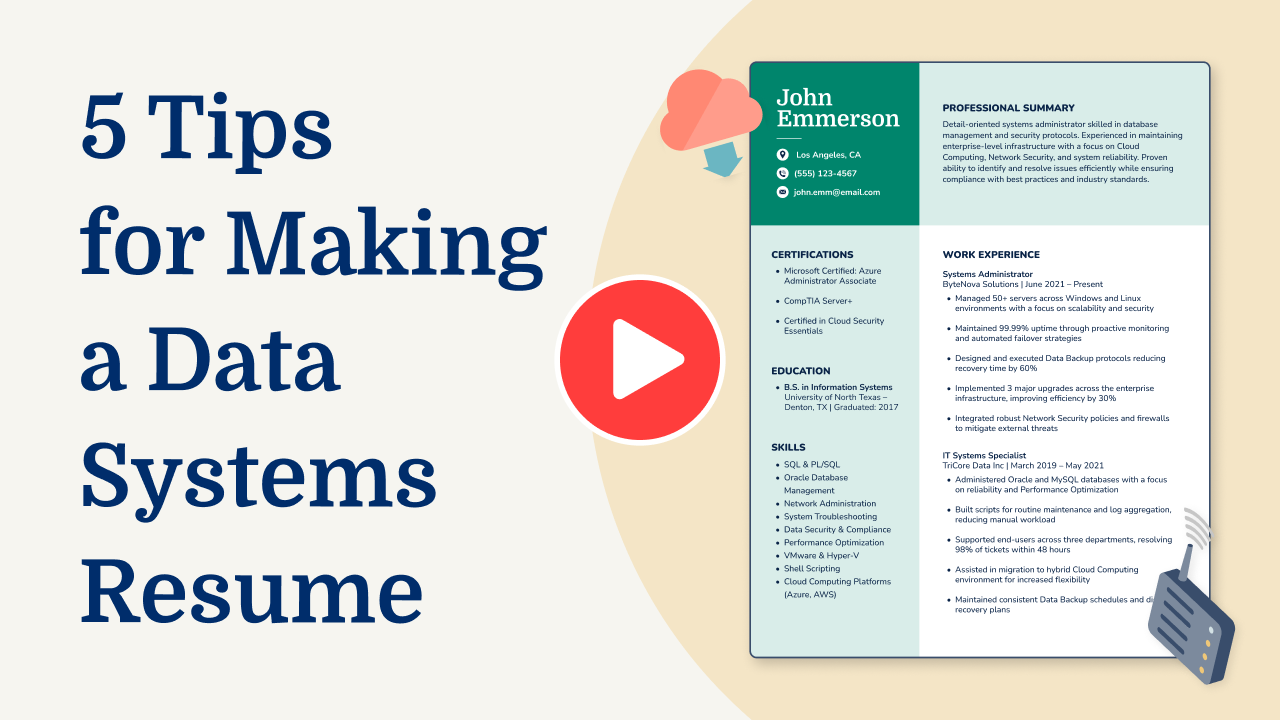
Highlight relevant technical skills
For a solutions architect, technical skills are really important. Having a dedicated technical skills section on your resume can help you showcase these abilities clearly. This section should list key skills like cloud computing, software development, and system design.
You might also include experience with specific tools or platforms such as AWS or Azure. If you’ve worked with programming languages like Python or Java, make sure to include them too. Highlighting these capabilities helps employers see that you have the knowledge needed for the job.
Sometimes it’s helpful to weave technical skills into your work experience section instead of listing them separately. This way, you can show how you’ve applied your expertise in real-world scenarios. For example, you could mention developing a cloud-based solution that improved company efficiency by 20%. This not only demonstrates what you know but also how you’ve successfully implemented it.
Solutions architects often need strong problem-solving abilities and must understand both hardware and software systems. Commonly sought-after skills include database management, network architecture, and security protocols. Whether listed in their own section or integrated into job descriptions, these technical details can set you apart from others applying for similar roles.
Example of a technical skills section
- Cloud platforms (AWS, Azure, Google Cloud)
- Infrastructure as code (Terraform, CloudFormation)
- Containerization (Docker, Kubernetes)
- Microservices architecture
- Networking and security protocols
- API design and integration
- Databases (SQL, NoSQL)
- DevOps practices and CI/CD pipelines
- Agile and Scrum methodologies
- Serverless computing
Employers love when you show soft skills like teamwork, communication, and adaptability because they know you can handle challenges and work well with others.
Quantify your accomplishments
Quantifying accomplishments on your resume makes it stand out by showing measurable results rather than just listing responsibilities. For a solutions architect, this means highlighting the impact of your work using numbers, percentages, or other metrics.
Instead of stating that you “designed systems,” explain how you “improved efficiency by 30%” or “reduced project costs by $50,000 through innovative solutions.” Hiring managers are drawn to resumes that clearly show what you achieved in each role because it helps them quickly understand the value you can bring to their organization.
In the work experience section, each entry should include your job title, employer name, location, and employment dates. Then, focus on turning duties into achievements by emphasizing quantifiable outcomes.
For example, instead of saying you “led a team,” specify that you “managed a group of 10 developers to complete projects two weeks ahead of schedule” or “increased system scalability by 40%.” Use action verbs like “optimized,” “streamlined,” or “improved” to start each bullet point and pair them with metrics that demonstrate success.
By presenting quantified accomplishments, you create a results-driven resume that captures attention and showcases your skills as a solutions architect. It allows hiring managers to see the real-world impact of your expertise quickly and efficiently.
5 solutions architect work history bullet point examples
- Architected scalable cloud solutions for enterprise clients, improving system performance by 25% and reducing costs by 30%.
- Led the integration of microservices architecture, improving application scalability and decreasing deployment time by 40%.
- Collaborated with cross-functional teams to design and implement a robust data analytics platform, resulting in a 50% increase in data processing speed.
- Developed API strategies that improved interoperability between systems, leading to a 20% reduction in development time.
- Spearheaded the migration of legacy systems to cloud infrastructure, achieving a 99.9% uptime and saving $500,000 annually.
Looking for ideas to make your resume stand out? Check out our professional resume examples to see how experts do it.
Write a powerful professional summary
A professional summary is a brief introduction on your resume designed to grab the attention of hiring managers instantly. It’s a key section that helps them decide whether to consider you for the role. When crafting a resume, you can choose between a professional summary or a resume objective.
Typically, a professional summary is three to four sentences long and highlights your experience, skills, and achievements. It suits those who have been working for some time and want to quickly convey their professional identity and value. This section informs employers about what you’ve accomplished in your career.
Conversely, a resume objective emphasizes your career goals, making it ideal for individuals just starting out, switching careers, or with long gaps in employment. Simply put: a summary tells “what I’ve accomplished,” while an objective states “what I aim to contribute.”
Next, review examples of both summaries and objectives tailored to various levels of experience to help you see how to write your own.
Solutions architect resume summary examples
Entry-level
Recent graduate with a Bachelor of Science in Computer Science and a focus on cloud computing and data architecture. Completed an AWS Certified Solutions Architect – Associate certification, demonstrating foundational knowledge in designing secure and robust solutions. Eager to apply academic knowledge and skills in cloud environments to develop innovative IT solutions.
Mid-career
Solutions architect with over seven years of experience in designing and implementing scalable systems across finance and healthcare industries. Proven track record of optimizing cloud infrastructures, reducing costs by 30% through strategic resource allocation. Strong background in serverless architectures and microservices, holding certifications in AWS Certified Solutions Architect – Professional.
Experienced
Accomplished solutions architect with 15+ years in the tech industry, specializing in enterprise-level system integrations and digital transformation projects. Expert in leading cross-functional teams to deliver solutions that drive efficiency improvements of up to 50%. Holds multiple advanced certifications including Google Cloud Professional Cloud Architect, known for fostering innovation and aligning technology strategies with business goals.
Solutions architect resume objective examples
Entry-level
Aspiring solutions architect with a background in computer science and experience in software development looking to transition into architecture roles. Eager to leverage programming skills and analytical thinking to design efficient, scalable IT solutions that address business challenges.
Career changer
Detail-oriented project manager with a successful track record in IT project delivery seeking to shift into solutions architecture. Focused on applying project management expertise and problem-solving abilities to develop strategic technical solutions that drive business growth.
Recent graduate
Driven recent computer engineering graduate keen on starting a career as a solutions architect. Committed to using strong technical skills and innovative thinking acquired through academic projects and internships to contribute effectively in designing robust IT infrastructures.
Choose a simple resume template with clear sections and easy-to-read fonts. Skip fancy designs or bright colors—stick to clean layouts so employers can focus on your skills and experience.
Showcase your credentials
Listing your credentials is important for a solutions architect because it shows you have the right skills and knowledge. Certifications, licenses, and specialized training prove that you are up-to-date with the latest technologies and best practices.
In technical fields, these credentials can set you apart from others by highlighting your commitment to learning and growing in your field. Creating a dedicated certifications section on your resume makes it easy for employers to see what you know.
Some certifications that can strengthen your solutions architect resumes include:
- AWS Certified Solutions Architect
- Google Professional Cloud Engineer
- Microsoft Certified: Azure Solutions Architect Expert
- Certified Kubernetes Administrator (CKA)
- CompTIA Security+
Having these certifications can give you an edge as a solutions architect by showing that you’re ready to tackle complex challenges. They complement your education section by providing proof of ongoing learning. By listing them prominently, you make sure potential employers notice your qualifications.
Example of a certifications section
AWS Certified Solutions Architect – Professional
Issued by: Amazon Web Services (AWS)
Expires 2025
Certified Kubernetes Administrator (CKA)
Issued by: Cloud Native Computing Foundation
Issued 2023
Google Cloud Professional Cloud Architect
Issued by: Google Cloud
Expires 2026
Microsoft Certified: Azure Solutions Architect Expert
Issued by: Microsoft
Issued 2022
TOGAF 9 Certified
Issued by: The Open Group
Expires 2026
Include either the issue date or expiration date of each of your certifications and licenses to show that your credentials are current.
FAQ
Do I need to include a cover letter with my solutions architect resume?
Yes, including a cover letter with your solutions architect resume can give you an edge by highlighting your unique qualifications and enthusiasm for the role.
For instance, if the organization uses AWS or Azure, you can emphasize relevant certifications or experience designing scalable systems within those platforms.
You can craft a personalized letter that complements your resume by focusing on how your problem-solving skills have driven measurable business outcomes in past projects.
If you need help creating an engaging letter, consider using our Cover Letter Generator to help you create a tailored document that explains how your technical expertise aligns with the company’s specific needs.
Also, consider reviewing cover letter examples to ensure yours effectively showcases both your technical knowledge and ability to collaborate across teams.
How long should a solutions architect’s resume be?
For a solutions architect, the length of your resume can vary. If you’re just starting out or have fewer experiences, aim for a one-page resume that highlights your technical skills, key projects, and certifications relevant to architecture solutions.
If you have extensive experience or numerous specialized skills and achievements, a two-page resume might be more suitable. Focus on major projects that show your ability to design scalable systems and solve complex problems.
Check our guide on how long a resume should be for examples tailored to your career stage.
How do you write a solutions architect resume with no experience?
If you’re new to the solutions architect role, your resume should spotlight relevant skills, education, and projects that show you can succeed. Follow these tips for crafting a resume with no experience.
- Emphasize education and certifications: Start with your degree in computer science, engineering, or a related field. Then list any certifications that are relevant to the role like AWS Certified Solutions Architect or TOGAF.
- Leverage project experience: Highlight academic projects or personal projects where you’ve designed systems or solved complex problems. Describe technologies used and outcomes achieved.
- Showcase transferable skills: Focus on skills such as problem-solving, system design, technical writing, and communication. If you’ve worked in roles like software development or IT support, explain how those experiences contribute to your readiness for solutions architecture.
- Include relevant coursework: List classes related to systems architecture, cloud computing, networking, and programming languages that align with the job requirements.
Tailor each section of your resume to reflect how it prepares you for the challenges of a solutions architect position.
Rate this article
Solutions Architect
Additional Resources
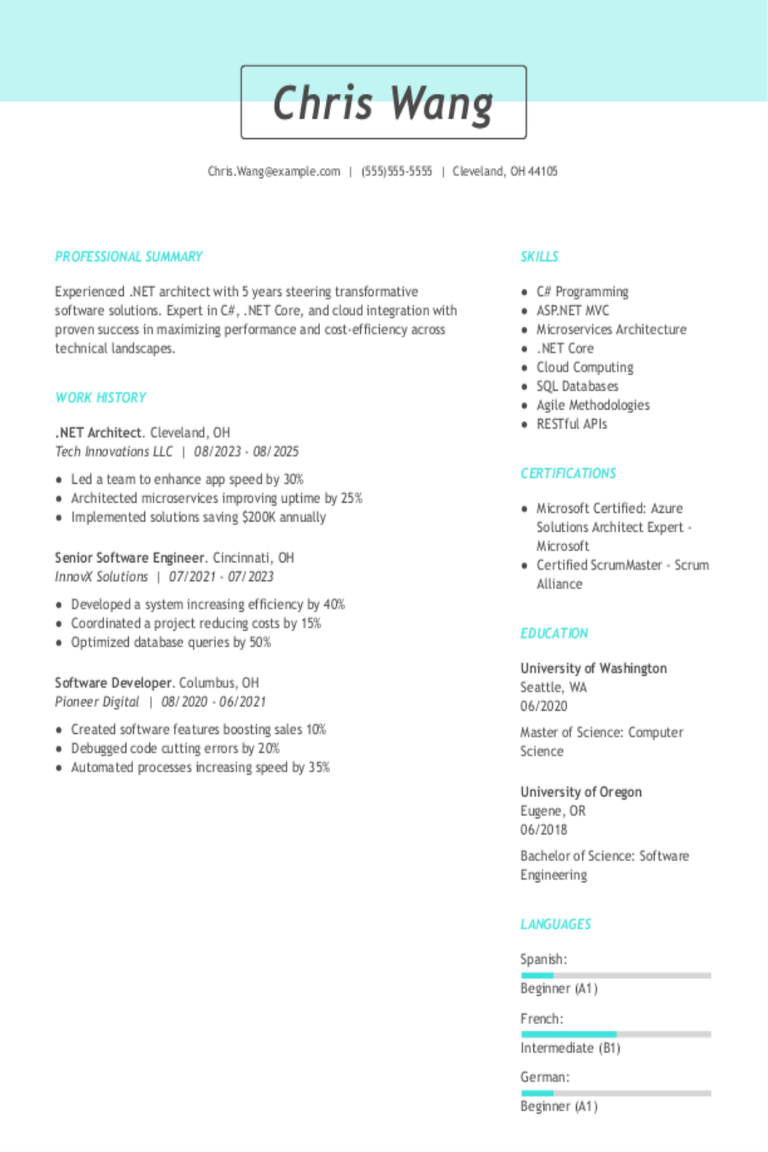
.NET Architect Resume Examples & Templates for 2025
Explore .NET architect resume examples that showcase design skills and problem-solving abilities. Discover tips to highlight your experience with software development and teamwork to impress hiring managers and win more
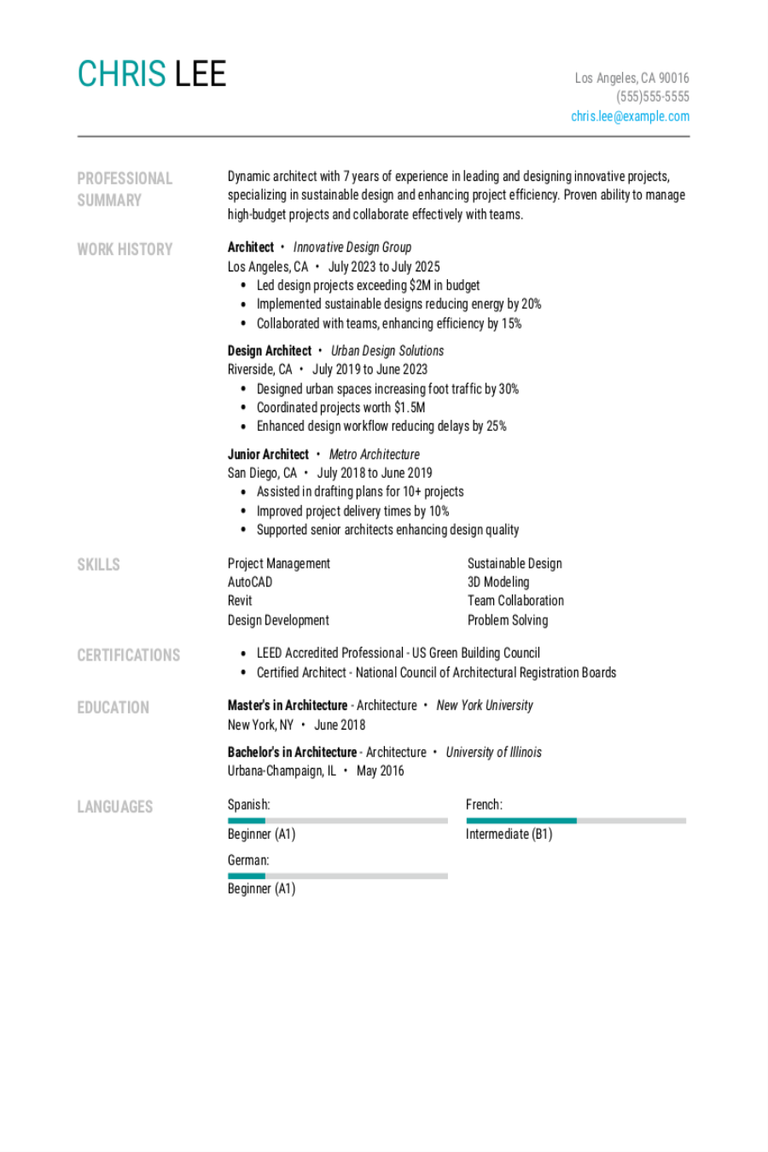
Architecture Resume Examples & Templates for 2025
Explore architecture resume examples and tips to learn how to showcase your creativity and experience designing buildings, creating plans, and working with teams.Build my resumeImport existing resumeCustomize this templateWhy
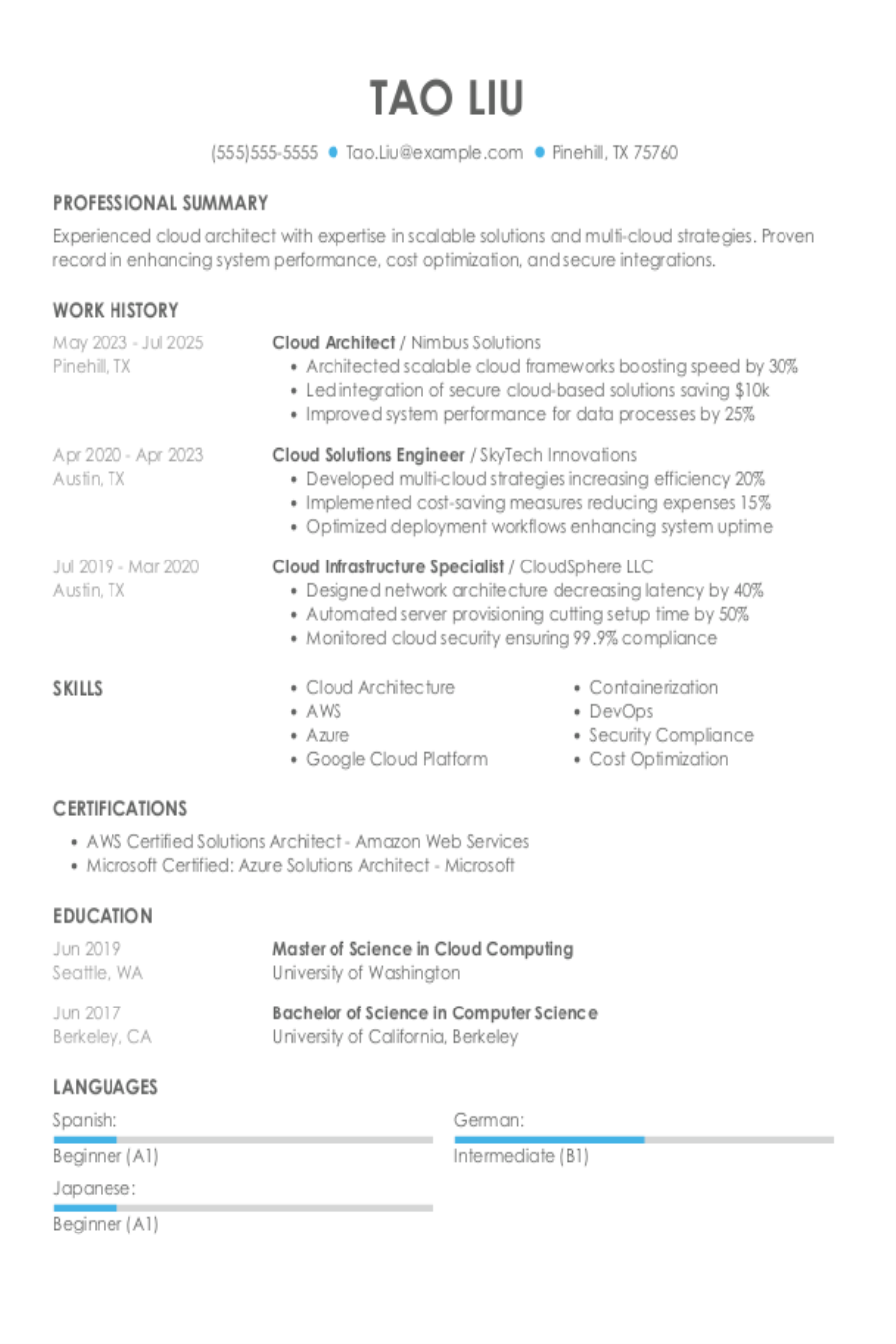
Cloud Architect Resume Examples & Templates for 2025
These cloud architect resume examples and tips will guide you to create a resume that highlights your experience with cloud platforms and solutions.Build my resumeImport existing resumeCustomize this templateWhy this
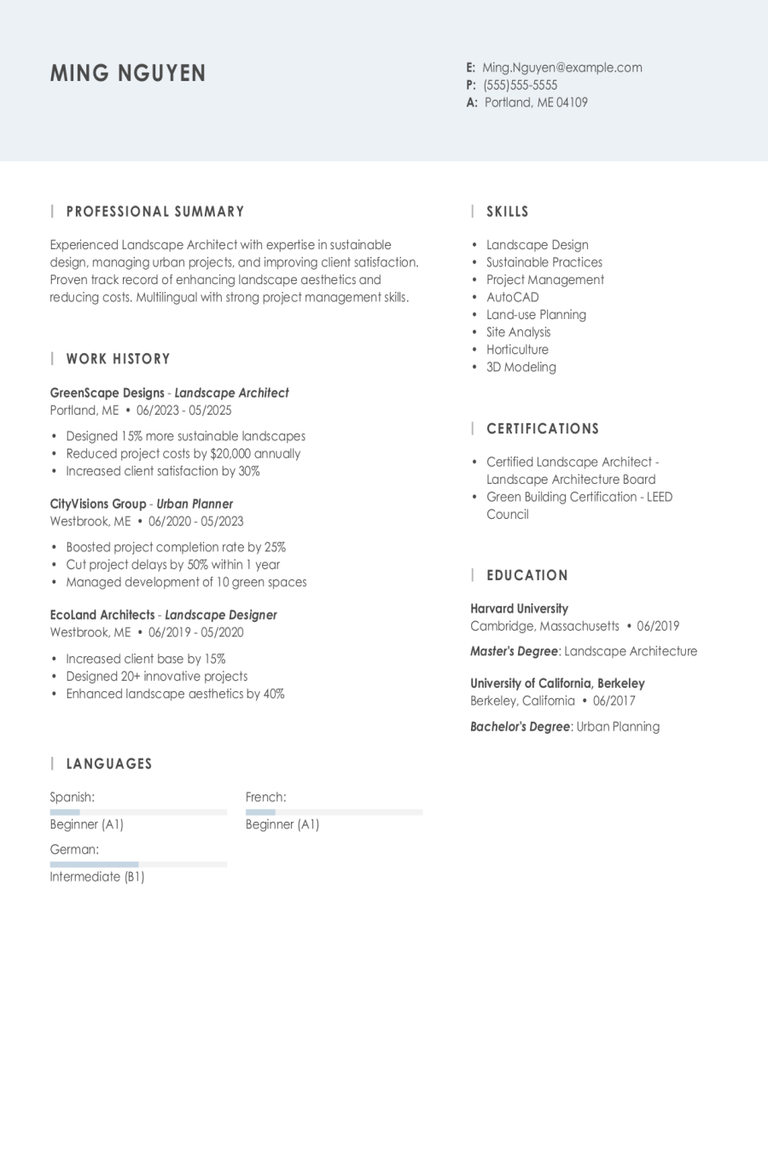
Landscape Architect Resume Examples & Templates for 2025
Explore landscape architect resume examples and tips to learn how to showcase your project management skills and experience with site planning, client collaboration, and sustainable solutions.Build my resumeImport existing resumeCustomize

Architect Resume Examples & Templates for 2025
Explore architect resume examples and tips to learn how to showcase your design skills, project experience, and technical knowledge effectively.Build my resumeImport existing resumeCustomize this templateWhy this resume worksQuantifies
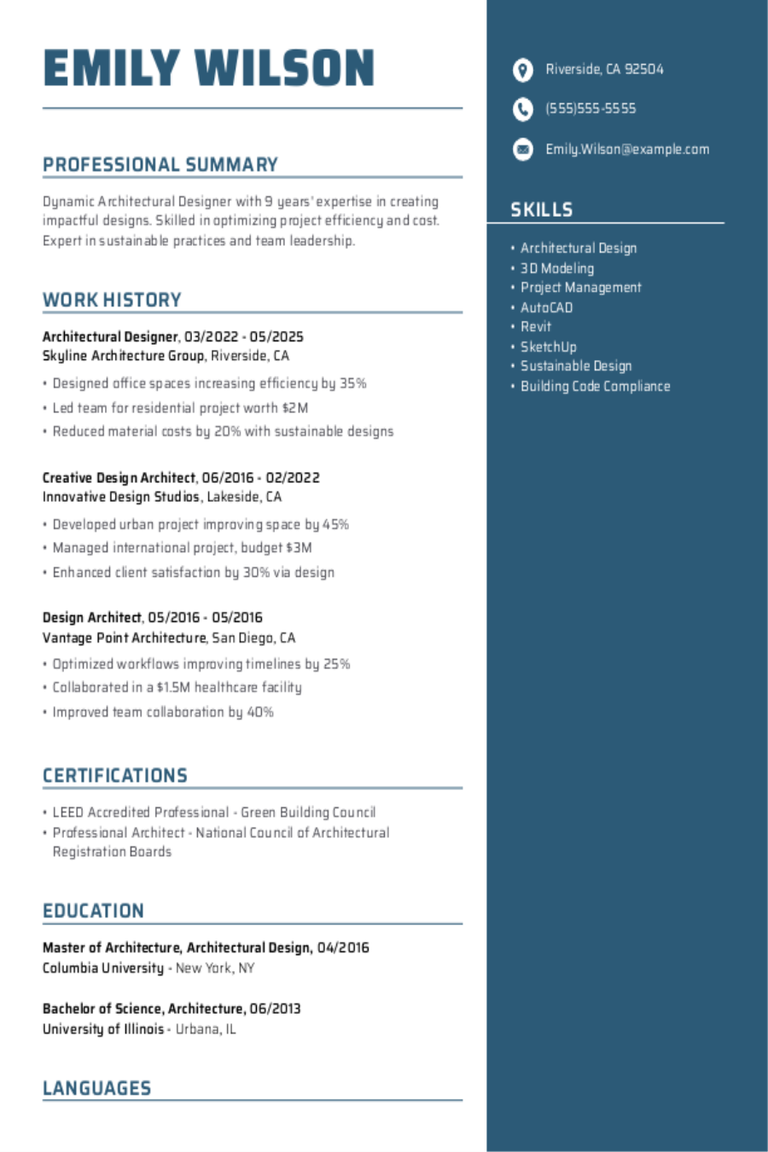
Architectural Designer Resume Examples & Templates for 2025
Explore architectural designer resume examples that show how to highlight your creativity, technical skills, and experience with design software.Build my resumeImport existing resumeCustomize this templateWhy this resume worksQuantifies accomplishments: The applicant’s
